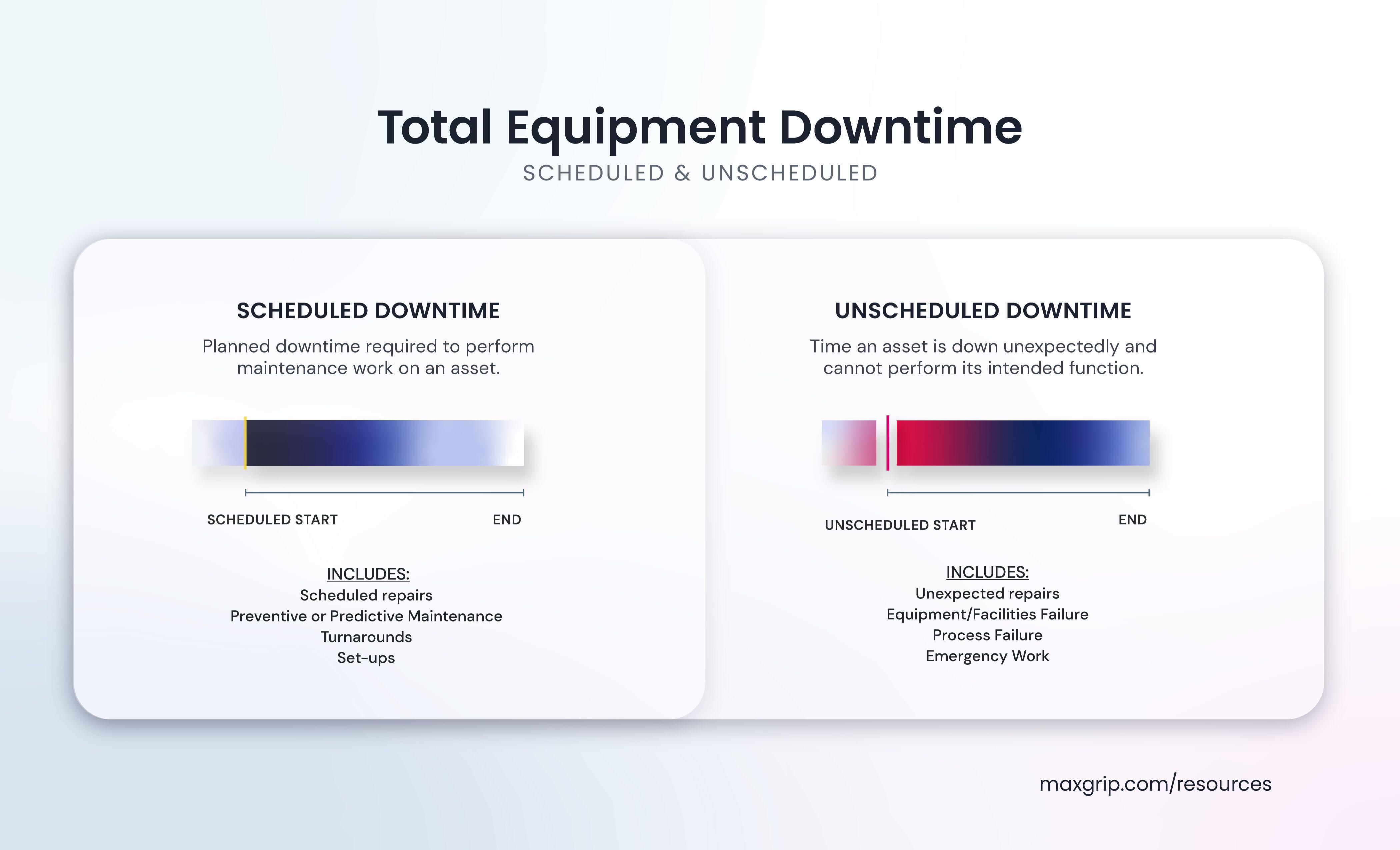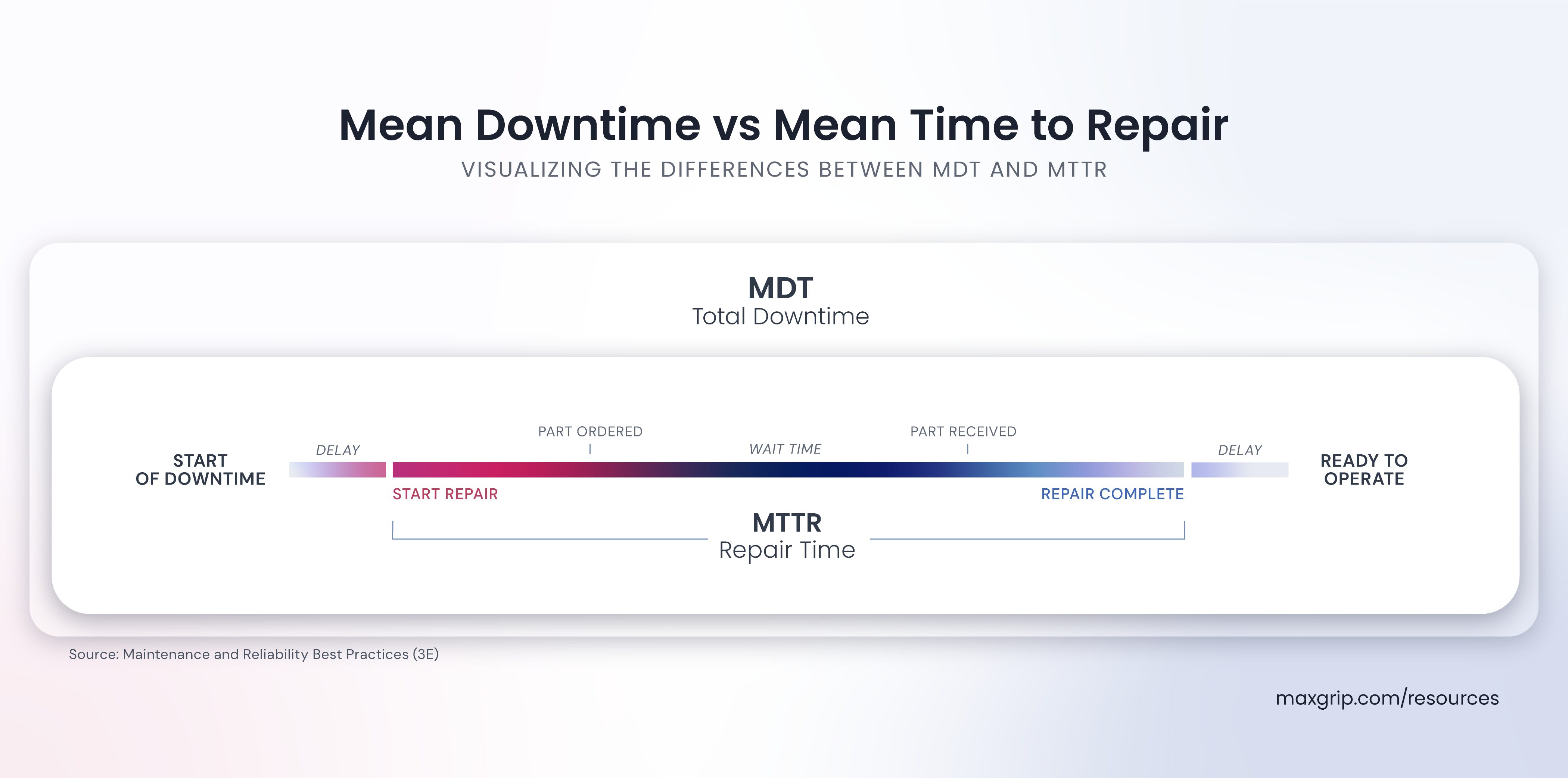Our discussion on reliability metrics and how to use these to inform your maintenance and reliability decision-making continues by discussing equipment downtime, specifically on the topic of Mean Downtime, or MDT, and how to use this metric to your advantage.
Key Takeaways
- Mean Downtime is the average amount of time that an asset is required to be down to perform maintenance and repairs
- Mean Downtime calculation formula = Total Downtime / # of Downtime Events
- Downtime can be costly – a study found that downtime can cost up to $260k USD/hr.
- Scheduled downtime is downtime that appears on a weekly maintenance schedule
- Unscheduled downtime is the time an asset is down unexpectedly
- Whereas MDT covers the entire time span that an asset, Mean Time to Repair is the average time it takes to repair an asset and strictly covers the time spent repairing the asse
Downtime is often associated with lost production, lost revenue, and sometimes even lost customers.
The truth is that downtime is necessary – it is needed for maintenance, repairs, upgrades, and replacements. Where the distinction lies is how controllable the amount of downtime is and whether there is a system in place, such as a compatible maintenance program, to detect and measure how much time is spent on unplanned, prolonged, and costly downtime.
This article is a continuation of our discussion on reliability metrics, specifically on the topic of Mean Downtime, or MDT, and how to use this metric to your advantage. Further, it shares insights on how to control the downtime of your assets.
To begin the discussion, we must start at the beginning, which is by defining equipment downtime.
What is equipment downtime?
Equipment Downtime is the timeframe that an asset is not in operation and results in a pause in production. For many manufacturers and maintenance teams, equipment downtime is the leading contributor to decreased production. It can be costly as well – a study suggests that downtime can cost up to $260k USD/hr.

Scheduled Downtime
Scheduled downtime is downtime that appears on a weekly maintenance schedule and includes the time spent from initial shut down to performing maintenance work on an asset. It ends when the asset is once again available and in operation. The frequency and criticality of scheduled downtime is typically the result of an organization’s maintenance philosophy.
Examples of scheduled downtime
- Scheduled repairs
- Preventive Maintenance or Predictive Maintenance
- Turnarounds
- Set-ups
Unscheduled Downtime
Unscheduled downtime is the time an asset availability is down unexpectedly and cannot perform its intended function. It has a direct impact on revenue as it includes more than a delay in production. A study by Efficient Plant found that unplanned downtime in manufacturing and heavy process industries “can impact 1-3% of revenue and potentially 30-40% of profits annually”.
It includes the delay time spent on repairs and modifications that are not on a maintenance schedule, including ordering parts when not available. In fact, close half of all unscheduled downtime can be traced to not having adequate spare parts.
Examples of unscheduled downtime incidents
- Unexpected machine repairs (e.g., ruptured belt, broken component)
- Machine/Facilities Failure
- Operational Issues
- Process Failures
- Emergency work
Equipment Downtime Analysis
Equipment downtime analysis is an important part of any reliability strategy. It involves assessing the percentage of time a piece of equipment is not operational due to factors such as maintenance, repair and/or replacement. By gathering data on downtime, organizations can pinpoint problems, identify solutions and optimize their maintenance and repair processes to reduce downtime and improve overall equipment reliability. Downtime analysis can also help organizations to identify areas for potential cost savings and improved productivity.
What is Mean Downtime (MDT)?
Mean Downtime is the average amount of time that an asset is required to be down to perform maintenance and repairs. It starts from the initial equipment failure and encompasses the time spent diagnosing, lockout/tag outs, waiting for replacement parts, and repairing the asset. It ends when the asset is back online and completing its intended function.
How to calculate MDT
The formula for MDT is the following:

MDT = Total Downtime / # of Downtime Events
Total Downtime = the amount of time an asset is not capable of running and is equal to the sum of Scheduled Downtime and Unscheduled Downtime.
Downtime Events = an event when an asset is down and is unable to perform its intended function.
Note: Mean Down Time is measured in hours or percentages.
What MDT calculations helps inform
- Used as a KPI to track improvements in a site’s availability
- Measures the effectiveness of an asset repair strategy, or its maintainability
- Highlights inefficiencies in repair processes and can inform your critical spare parts strategy.
- Tracks the progress of downtime reduction initiatives
The value of MDT is apparent – however, it is critical to also know how to keep this number under control when necessary.
Steps to Reduce Prolonged Equipment Downtime
The best way to reduce MDT is to enact preventive measures to avoid future downtime. Although it is easier said than done, there are several tried and proven methods for reducing downtime which simply require more strategic planning and scheduling.
Mean Downtime (MDT) vs Mean Time to Repair (MTTR)
Whereas MDT covers the entire time span that an asset, Mean Time to Repair is the average time it takes to repair an asset and strictly covers the time spent repairing the asset. In short, MDT provides a full picture of an assets downtime and can be used to identify areas where time is wasted and minimizes productivity.
The graphic below is a visual representation to help distinguish MDT and MTTR.

Conclusion
Mean Downtime is one of several maintenance metrics — MTTR, MTBF, and MTTF — which can be collectively used by maintenance teams to measure asset reliability. Reliability is what ensures asset performance and shapes the reputation of your organization, both inside and outside of the plant.
MaxGrip helps close the loop through our experienced engineering consulting services that pinpoint the exact areas for improvement that will decrease downtime and ensure reliable production. Our clients achieve this through our proven process called the Asset Improvement Program – in fact, it recently helped one of our clients achieve over $500k USD YoY savings.
The Asset Improvement Program benchmarks your site performance at an asset-level and provides a roadmap for tangible improvements. Learn how simple it is to get started on the road to improved asset performance by reading about the Asset Improvement Program.
🖥 Watch On-Demand: Foundational CMMS data
📰Continue Reading
- Using Data Insights to Strengthen Your Organization’s Maintenance Strategy
- How business context can influence asset performance benchmarks
- Reliability Metrics: Mean Downtime (MDT)
- Infographic: 5 Benefits of Tracking Equipment Downtime
- How to build a Preventive Maintenance program for long-term success
- Five tips to improve OEE
- Overall Equipment Effectiveness Cheet Sheet
Get inspired
The negative impact of unplanned downtime on the bottom line is significant. This article offers advice on how to minimize your downtime.
Vitens and MaxGrip host a webinar in Dutch on data driven maintenance, their process and learnings. Collaboration with the Dutch maintenance organization NVDO.
Reliability culture enables a failure prevention mindset to exist across an organization's entire workforce and goes beyond avoiding the failure of an asset.




